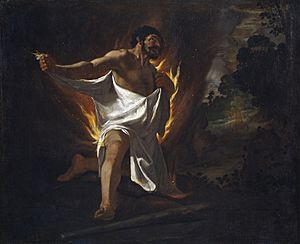The Death of Hercules facts for kids
The Death of Hercules is a painting from 1634 by a famous Spanish artist named Francisco de Zurbarán. Today, you can see this important artwork at the Museo del Prado in Madrid, Spain. It was part of a special series of paintings that told the exciting life story of the ancient hero Hercules. These paintings were created for a grand room called the Hall of Realms, located inside the Palacio del Buen Retiro, which was a royal palace.
Contents
The Story of Hercules' Death
This painting shows a very important moment from ancient Greek and Roman myths: the death of the mighty hero Hercules. Hercules was known for his incredible strength and for completing many difficult tasks, often called "labors." His death is a sad but powerful part of his legend.
Who Was Hercules?
Hercules, also known as Heracles in Greek myths, was a famous hero. He was the son of the god Zeus and a human woman named Alcmene. Hercules was incredibly strong and brave. He completed twelve very challenging tasks, like defeating monsters and capturing dangerous animals. These tasks made him one of the most celebrated heroes of all time.
Why Was This Painting Made?
The painting The Death of Hercules was created for a special place called the Hall of Realms. This hall was part of the Palacio del Buen Retiro, a large royal palace in Madrid. The king at the time, Philip IV, wanted to decorate this hall with paintings that showed his power and the greatness of Spain. The series of paintings about Hercules was chosen because Hercules was a symbol of strength, courage, and victory. By showing Hercules's life, the king wanted to suggest that he, too, was a powerful and heroic ruler.
What Does the Painting Show?
Zurbarán's painting captures the dramatic final moments of Hercules. According to the myth, Hercules was poisoned by a special tunic. The painting shows Hercules in great pain, struggling against the poison. He is often depicted with his famous club, a symbol of his strength. The artist used dark colors and strong contrasts to make the scene feel very intense and emotional. This helps viewers understand the hero's suffering and the tragic end to his legendary life.
See also
 In Spanish: Muerte de Hércules para niños
In Spanish: Muerte de Hércules para niños


